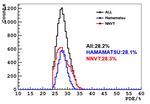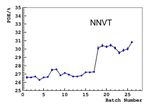Tested Performance of JUNO 20" PMTs - Journal of Physics: Conference Series - ResearchGate
←
→
Page content transcription
If your browser does not render page correctly, please read the page content below
Journal of Physics: Conference Series
PAPER • OPEN ACCESS
Tested Performance of JUNO 20” PMTs
To cite this article: Haiqiong Zhang et al 2020 J. Phys.: Conf. Ser. 1468 012197
View the article online for updates and enhancements.
This content was downloaded from IP address 181.214.97.217 on 12/05/2021 at 04:24TAUP 2019 IOP Publishing
Journal of Physics: Conference Series 1468 (2020) 012197 doi:10.1088/1742-6596/1468/1/012197
Tested Performance of JUNO 20” PMTs
Haiqiong Zhang1∗ , Zhimin Wang1 , Wei Wang2 , Zhonghua Qin1 ,
Alexander Olshevskiy3 , Nikolay Anfimov3 , Björn Wonsak4 , Korablev
Denis3 , Tobias Lachenmaier5 , Tobias Sterr5 , Alexander Tietzsch5 ,
Jun Wang2 , Hang Hu2 , Rao Zhao2 , Jingyuan Guo2 on behalf of the
JUNO Collaboration
1
Institute of High Energy Physics, Chinese Academy of Sciences, Beijing, China
2
University of Physics, Sun Yat-sen University, Guangzhou, China
3
JointInstituteforNuclearResearch, Dubna,RussianFederation
4
Institute of Experimental Physics, University of Hamburg, 22761 Hamburg, Germany
5
Kepler Center for Astro and Particle Physics, Eberhard Karls Universität Tübingen,72076
Tübingen, Germany
Journal of Physics: Conference Series, IOP Publishing
E-mail: ∗ zhanghq22@ihep.ac.cn
Abstract. The physics goal of the Jiangmen Underground Neutrino Observatory (JUNO) is
mainly topdetermine the neutrino mass hierarchy by precisely measuring the oscillation spectrum
with 3%/ Evis (M eV ) energy resolution.Totally, about 20, 000 large area 20” tubes with high
photon detection efficiency will be used to achieve this requirement, including 5,000 Hamamatsu
dynode PMTs and 15,000 NNVT MCP PMTs. The JUNO collaboration has built two systems
to check the performances of these tubes, which have been running since July 2017 and about
14000 tubes have been tested, so far. The key parameters compared with vendor data, including
operating voltage, photon detection efficiency, dark count rate, rise time, fall time are presented.
The selected PMTs meet all the requirements of the JUNO detector.
1. Introduction
The Jiangmen Underground Neutrino Observatory (JUNO) [1] is a multipurpose neutrino
experiment designed mainly to determine neutrino mass hierarchy and precisely measure
oscillation parameters by detecting reactor neutrinos from the Yangjiang and Taishan Nuclear
Power Plants in China. The detector will be equipped with 20 kton LS with a 700-meter rock
overburden and housing 20,000 large area photomultipliers (PMT) with 75% PMT coverage to
achieve energy resolution (sigma) 3% at 1MeV [2].
The 20,000 large area 20” tubes with high photon detection efficiency, configurated
combinedly by 5,000 20” dynode PMTs from Japanese company Hamamatsu Photonics
(HAMAMATSU) and 15,000 20” Micro Channel Plate (MCP) PMTs from Chinese company
North Night Vision Technology Co. (NNVT), are supposed to be measured according to specified
acceptance criteria before potting and installation. Since the experimental engineering progress
and the large number of PMTs, two container testing system as well as two scanning stations are
built and calibrated with different testing motivations, and they have been running since July
2017. The electronical performance, including operating voltage, photon detection efficiency,
dark count rate, rise time and fall time, would be studied for each PMT in the acceptance test.
Content from this work may be used under the terms of the Creative Commons Attribution 3.0 licence. Any further distribution
of this work must maintain attribution to the author(s) and the title of the work, journal citation and DOI.
Published under licence by IOP Publishing Ltd 1TAUP 2019 IOP Publishing
Journal of Physics: Conference Series 1468 (2020) 012197 doi:10.1088/1742-6596/1468/1/012197
2. Performance testing system
The new-arriving PMTs are stored in Zhongshan Pan-Asia in south of China, where the
performance testing systems are installed.Two containers test systems with electromagnetic
shielding were designed for mass acceptance tests and converted from commercial shipping
containers. Each container consists of 36 individual drawers as shown in the left of Fig.1.
Commercial electronics are adopted for noise count as well as waveform acquisition, and a
schematic layout is displayed in the right of Fig.1.
Besides, two scanning stations [3] are set up to calibrate the photon detection efficiency
(PDE) from 168 point-like light sources to the surface PDE, which is crucial to obtain the PDE
for large area PMTs. As well, the scanning station is used to scan the uniformity of tubes and
double-check the PDE on the boundary of the requirement from the containers considering the
system uncertainty.
Figure 1. The Container: general view (left) and schematic layout of the single channel
commercial electronics setup (right).
Figure 2. Scanning station general view in the dark room (left) and rotating support(right).
3. Testing and analysis procedures
PMT acceptance test procedures are designed and implemented, where several parameters
(charge resolution, peak/valley, operating voltage applied to reach gain of 107 , pre-pulse, rise/fall
time) would be re-tested in container systems if they are not satisfied as the contract defines
in the first measurement. Besides, we handle the dark count rate (DCR) more carefully, since
temperature and cool-down time would affect the DCR of PMTs. Following the procedures,
another check in scanning station is needed if the DCR failed twice in container systems. PDE
2TAUP 2019 IOP Publishing
Journal of Physics: Conference Series 1468 (2020) 012197 doi:10.1088/1742-6596/1468/1/012197
is the most important parameter for JUNO PMTs. To ensure the average PMT detection
efficiency is above 27%, the threshold has been set to 24% for PDE measurement. Considering
the PDE absolute uncertainty is 1% for container systems, the PMTs would be rejected directly
in container if their PDE value are below 23% and they also need to be confirmed in scanning
stations when their PDE is between 23% and 25%.
4. Preliminary results
Until now, more than 12500 (5000 Hamamatsu tubes and 7500 NNVT tubes) tubes has been
tested with the two containers regarding the operating voltage, amplitude, resolution, P/V, rise
time, fall time, DCR and PDE, and the preliminary mean of statistics based on the acceptance
tubes has been listed in Table 1. It is worth mentioning that the average PDE of all NNVT
tubes keeps the same level as the average PDE of HAMAMATSU. Furthermore, the NNVT
PDE plot with bias shows a great improvement after the 18th delivery batch number and the
average PDE of new tubes after 18th batch is higher than average PDE of HAMAMATSU. The
distribution of PDE has been exhibited in Fig.3.
Figure 3. PDE distribution based on the acceptance tubes in container system. Left: PDE of
NNVT and HAMAMATSU; right: PDE vs delivery batch number.
Table 1. Mean value of the parameter statistics(Amplitude (Amp), Resolution (Res))
PMT HV PDE DCR Amp Res Rise Fall
P/V
Type /V /% /KHz /mV /% Time/ns Time/ns
NNVT 1766 28.3 48.3 7.5 32.4 4.1 4.8 16.5
HAMA 1863 28.1 15.3 6.4 27.9 3.8 6.9 10.2
5. Conclusion
Large area PMT acceptance tests on performances have been running since July 2017 following
the test procedures. Until now, the mass test systems are working well and more than 14000
tubes inspection has been finished.
6. References
[1] F.An et al, JUNO collaboration, JUNO Conceptual Design Report, arXiv:1508.07166.
[2] F.An et al, J. Phys. G. 43 (2016) 030401, arXiv: 1507.05613
[3] Anfimov N. Large photocathode 20-inch PMT testing methods for the JUNO experiment[J]. Journal of
Instrumentation, 2017, 12(06): C06017.
3You can also read























































